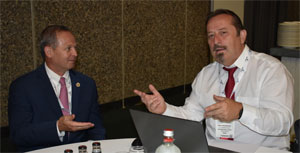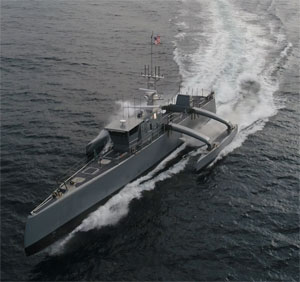Imagine all sorts of merchant ships plying the oceans and bays without any crew on board. They’re not ghost ships like Mary Celeste, but they might as well be as far as some maritime careers are concerned. Different types of maritime autonomous surface ships (MASS) are here, and more are coming soon.
Many countries see them as a way to increase the safety and efficiency of commerce while reducing pollution. Some nations have already enacted MASS laws for their own waters, but the International Maritime Organization (IMO) is still studying the regulatory issues for global waters.
One of the delegates to the IMO’s Maritime Safety Committee (MSC) is Swedish representative Henrik Tunfors. He recently reported that the MSC has adopted a carefully measured approach regarding international MASS regulations. The panel has divided MASS into four categories, and it has launched a scoping exercise to identify areas of concern. The next step is to research each of those areas in detail with additional multiple studies. Then, the MSC will decide which recommendations to bring forth for the International Regulations for Preventing Collisions at Sea (COLREGS).
COLREGS stipulates that potential changes should be made every four years. The COLREGS year of 2020 will be much too soon for ratification by IMO member nations because studies and discussions will still be ongoing at that time. COLREGS 2024 is the soonest possible year for ratification by the international body, but 2028 probably will be the year that the new MASS regulations are ratified and go into effect. The IMO is more concerned about getting it right the first time than pushing for changes too soon. Many countries aren’t waiting that long, though, and they are enacting their own MASS regulations.
You can argue that the primary force driving MASS is to eliminate jobs in order to save money, but it’s hard to argue against the safety numbers. About 77 percent of all vessel collisions involve human error; the remainder are due to mechanical failures. If humans are replaced with artificial intelligence maneuvering (AIM), you have advanced computer systems to avoid collisions, and you also get precision courses and throttle controls as a bonus. That saves fuel and therefore helps the environment. Many governments have mandates about saving the environment, and some — Belgium, the Netherlands and Norway among them — have already amended their local laws to allow for MASS.
MASS in the United States is a serious subject that will affect merchant mariner jobs. There are a lot of rumors floating around about MASS testing here, but I wanted concrete answers for our professional mariners. I contacted the U.S. Department of Transportation and was directed to the Maritime Administration (MarAd). After some lengthy negotiations, Deputy Administrator Richard Balzano agreed to meet me in Amsterdam at the 2019 Autonomous Ship Technology Symposium for an exclusive interview about MASS in the U.S. Here is an excerpt of the discussion.
 |
|
MarAd’s Richard Balzano, right, “gave as good as he got” during an interview with Capt. Marc Deglinnocenti, left, at the Autonomous Ship Technology Symposium in Amsterdam in June. The author questioned the deputy administrator about the rise of uncrewed ships and whether the technology could jeopardize merchant mariner jobs. |
|
Courtesy MarAd/Capt. Marc Deglinnocenti |
Deglinnocenti: What are the primary missions of MarAd?
Balzano: One of the main missions is to maintain a strategic sealift capability for the United States. Just one example of that is having a Ready Reserve Fleet. We actively promote mariner education through our maritime academies and other schools and courses, and we also heavily invest in our U.S. maritime transportation system and its infrastructure.
Deglinnocenti: In what ways do you see foresee MASS enhancing or detracting from those missions?
Balzano: If MASS is developed correctly, it can improve the safety and efficiency of the maritime industry. I also foresee some great cost reductions for MASS owners and operators, all while reducing carbon footprints.
Deglinnocenti: Would you agree that regardless of how popular MASS becomes, a well-trained and experienced supply of merchant mariners will still be vital to the smooth flow of seaborne commerce, and for national security?
Balzano: Absolutely yes. MASS may reduce some skilled positions in some areas, but we still need experienced people with those skill sets. Even though we might have to refocus some of our workforce, those basic individual skilled merchant mariners are still needed and valued by MarAd.
Deglinnocenti: Many current and future professional mariners want to know how MASS will be affecting their careers. Some workers fear losing their jobs to MASS, while some vessel owners and operators see MASS as a way to combat future workforce shortages. Do you think MASS will have an overall negative effect on future maritime careers, or is there room for both MASS and shipboard personnel?
Balzano: There will always be room for both MASS and a merchant mariner workforce. Besides, it will be many years before fully autonomous merchant vessels are perfected and internationally legalized. If any shipboard jobs are phased out during that long stretch, they will be replaced by phasing in more shore-based maritime jobs.
Deglinnocenti: Does MarAd have any specific proposed laws regarding MASS that it would like to see ratified by member nations of the IMO?
Balzano: Not at this time, because the Maritime Safety Committee’s regulatory scoping exercise is not nearly finished. However, we are carefully monitoring the IMO regulatory situation.
Deglinnocenti: The U.S. Coast Guard has sent Rear Adm. John Nadeau to London to be the U.S. representative on the Maritime Safety Committee. Is MarAd currently working with the Coast Guard on MASS safety and security, and do you get any updates from Nadeau?
Balzano: Yes, I’ve been in contact with him as well as other U.S. Coast Guard personnel. We are also communicating with the U.S. Army Corps of Engineers and the U.S. Navy. We have been contacting them to initiate meetings about MASS, and they have initiated meetings with us.
Deglinnocenti: Since MarAd has an Office of Maritime Security that deals with threats such as piracy, terrorism and cyberattacks, does it see MASS as being particularly vulnerable to these threats due to a lack of crew on board?
Balzano: Cyberattacks are a huge concern for MarAd and many other agencies. The Navy is the most proactive combatant of potential cyberattacks, so we’ve been working with them and learning a great deal about OPCON (operational control) for MASS. This help from the Navy means that MASS will be far less vulnerable than originally thought.
 |
|
Maritime autonomous surface ships (MASS) will soon include vessels that go beyond commerce. Naval architects at Robert Allan Ltd. are working with technology specialists at Kongsberg to develop the RALamander, a remotely operated fireboat that will allow responders to more safely and aggressively attack port fires. |
|
Courtesy Robert Allan Ltd. |
Deglinnocenti: Some marine companies are promoting rudimentary artificial intelligence maneuvering (AIM) systems for MASS. Do you believe that currently available AIM systems are sufficient to avoid collisions in all possible scenarios?
Balzano: Yes. I’ve seen some very sophisticated AIM systems at work, and they are quite mature enough now to handle every possible collision scenario. The Navy’s AIM system on the Sea Hunter MASS test platform did very well crossing the Pacific Ocean. Canada and MarAd also worked together testing a MASS vessel. That AIM system successfully guided itself up the St. Lawrence Seaway without incident. It involved many complicated and constant AIM calculations and executions in some heavy traffic areas with draft constraints to consider too. Of course, it depends on the AIM product.
Deglinnocenti: Considering that some AIM systems have a long way to go yet, how do you feel about the fact that American merchant mariners on U.S.-flag ships will soon be interacting with foreign unknown AIM systems in international waters?
Balzano: Our mariners can deal with it. Fully autonomous ships are coming — it’s just a matter of time. Our professional mariners, both (domestic) and international, are currently using their own and dealing with other vessels’ more primitive degrees of AIM right now. Automation is nothing new to ships at sea. As an example, an autopilot is commonly used by today’s mariners. It’s one of the many autonomous forerunners of MASS. Humans will still be in the loop for a long time to come.
Deglinnocenti: Concerns have been voiced by some in the industry about MASS incidents in the middle of the ocean with very little traffic around. Those concerns include the risk of shipboard fires, hacking into AIM systems, mechanical breakdowns, piracy and other unauthorized boardings at sea. Do you think that fully autonomous U.S.-flagged merchant vessels will ever be crossing large stretches of international water?
Balzano: Yes, someday, but there has to be a fundamental shift in the way we build ships. There have to be more redundant systems, because there won’t be someone on board to repair failed equipment. We will also have to monitor MASS much more closely and constantly from remote shore control centers. We are not there yet, but we need to go there.
Deglinnocenti: The international treaty that requires mariners to render aid to those in need at sea might be severely compromised by MASS. How do you think that legal and moral conflict might be resolved?
Balzano: We are a long ways off before that. A human will be on board or in a control center in the case of fully automated vessels at first. These remote control centers can monitor radio distress calls and pick up other distress signals via cameras. MASS can then be diverted to vessels in distress. Even aerial drones can fly over to people in the water to drop ring buoys or other lifesaving devices. Unmanned vessels with robotic arms can even pluck unconscious or injured victims from the water. Some of that technology is already here.
With the future of maritime careers on the line, I pressed MarAd’s deputy administrator hard for answers. Balzano gave as good as he got, with the interview becoming a bit animated at times. He revealed a great deal about the future of MASS, maritime careers and MarAd’s attitude toward the new technology. Some careers will remain the same, some will be eliminated and some will be modified. One thing is certain, though: MASS is coming to the United States.
Capt. Marc Deglinnocenti is a maritime technical writer who recently served as a panelist at a forum on autonomous vessels at the Ship Operations Cooperative Program (SOCP) Spring Summit, held at the STAR Center in Dania Beach, Fla. His sea time dates to 1974 in a wide variety of roles on sailboats, conventional and tractor tugboats, training ships, barges, warships, cargo ships, passenger vessels and research vessels. He can be reached by emailing oldarmada@gmail.com.

